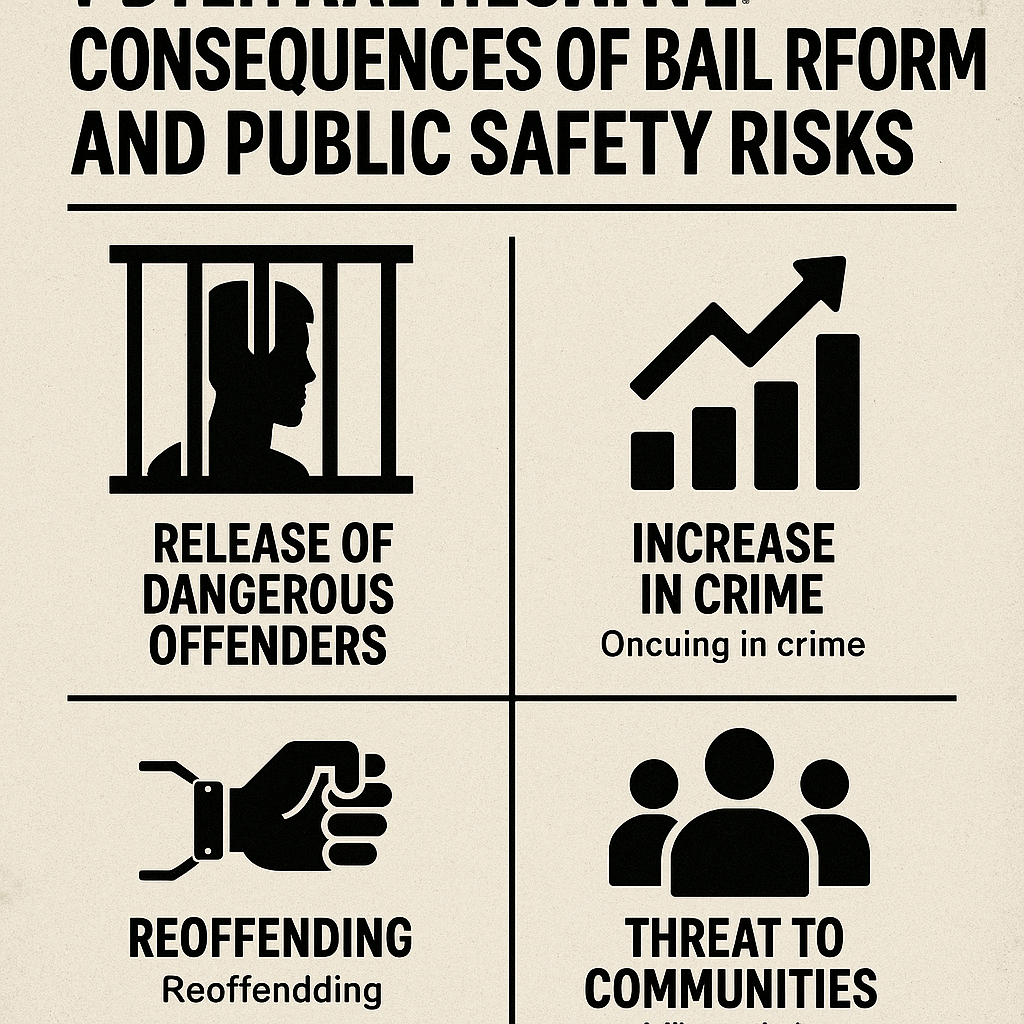View News
Potential-Negative-Consequences-of-Bail-Reform-and-Public-Safety-Risks

Potential Negative Consequences of Bail Reform and Public Safety Risks
~Sura Anjana Srimayi
INTRODUCTION
Bail reform, a movement gaining momentum across various jurisdictions, aims to address the inequities inherent in traditional cash bail systems. Proponents argue that wealth-based detention disproportionately affects low-income individuals, particularly those from marginalized communities, who are held pretrial simply because they cannot afford to pay. Reform initiatives tend to substitute or greatly restrict the application of monetary bail, opting for risk assessments and non-monetary release conditions instead. Although fairness and equity goals are commendable, critical analysis must also account for the possible adverse effects of such reforms, especially regarding public safety threats.
The Central Argument: Greater Risk of Reoffending
The main concern voiced by critics of liberal bail reform is the possibility of a greater risk of reoffending by those released pretrial without the incentive of financial collateral. The argument suggests that abolishing or drastically curbing cash bail may result in more people, who would otherwise have been in jail, being released into the community pending trial. This would, in turn, result in an increase in crime, including violent crimes, as some of these people would commit new offenses or not show up in court.
- The Presumption of Innocence and Public Safety: The foundation of the justice system is the presumption of innocence until conviction. Bail reformers place strong emphasis on this principle, suggesting that detention is the exception, not the rule, particularly for those with low risk. But critics say this emphasis sometimes leads to forgetting the state's role in public safety. They contend that although the presumption of innocence is necessary, pretrial release decisions ought also to fully take into account the potential risk a person could pose to society.
- Risk Assessment Limitations: A central part of numerous proposals for bail reform is the use of risk assessment instruments to ascertain the likelihood that an individual will reoffend or not appear in court. Although these instruments are intended to be more objective than strictly financial, their effectiveness and accuracy are topics of debate. Critics contend that these evaluations are not infallible and will not necessarily predict future actions, and as a result, individuals may be released who then go on to commit crimes.
- Real-life Example: In courts that have adopted bail reform with a heavy emphasis on risk assessments, there have been fears concerning the validity and reliability of these instruments, especially their capacity for predicting violent crime. Cases where offenders released on a low-risk assessment have proceeded to commit serious crimes are typically referred to as evidence of the limitations of the tools. The discussion tends to focus on what kinds of factors are being put into the measurements and how much weight is placed on previous criminal history compared to other markers.
Case Studies and Anecdotal Evidence
Though thorough, longitudinal data on the effects of systemic bail reform remains forthcoming, anecdotal evidence and initial studies have been used by both sides to support their cause.
- New York Bail Reform: New York State's bail reform, adopted in 2020 and later revised, has become a central subject of this controversy. The reforms, initially, abolished cash bail for most misdemeanor and non-violent felony offenses. In reaction to increases in crime rates in certain communities, opponents claimed that the bail reform was a causative factor, citing certain cases of individuals released on their own recognizance being rearrested for additional offenses, in some cases, serious offenses. Real-life Example: There were a number of high-profile cases in New York involving people who were released under the original bail reform and subsequently indicted for violent crimes. These were highly publicized and contributed to the narrative that the reforms were putting public safety at risk. For example, the arrest of people released on non-monetary terms for follow-on violent crimes was most commonly produced by opponents of rolling back the reforms.
- Yolo County, California Study: The Yolo County District Attorney's Office in California carried out a study of recidivism among individuals released on "zero bail" during the COVID-19 pandemic versus those released on conventional bail. The study allegedly revealed far higher re-arrest rates, including violent crime, for those released on zero bail. Real-life Example: The Yolo County study had specific examples of individuals released under zero bail getting rearrested for serious crimes such as murder, attempted murder, and robbery, prompting the District Attorney to opine that the zero bail policy undermined public safety. These factors, including the pandemic backdrop and the ad hoc nature of the zero bail policy in this case, have to be carefully weighed while applying these results as a general theory.
- Contrasting Evidence: It is also important to highlight that differing analyses and research have provided divergent findings. Certain studies have reported that there has not been a significant upsurge in crime rates because of bail reform and, in a few instances, it is actually linked with reduced recidivism for certain groups. These reports tend to stress the multi-dimensional causes behind crime rates and the need not to solely assign an increase in the context of bail reform. Real-life Example: Research comparing the influence of bail reform in states such as New Jersey, which made substantial changes several years ago, have not always indicated a direct correlation between the reforms and higher crime rates. There are even some indications that recidivism rates have stabilized or reduced slightly in some categories.
The Role of Pretrial Services and Support
Supporters of bail reform frequently contend that success with non-monetary release depends upon a strong and active implementation of pretrial services and support programs. These may involve supervision, drug testing, mental health treatment, and reminders to appear in court. The thought is that such services can resolve problems that may lead to reoffending and enforce compliance with court orders, potentially reducing risks from releasing individuals without collateral.
- The Requirement of Sufficient Funding and Infrastructure: A key challenge in the provision of effective pretrial services is the requirement of sufficient funding and infrastructure. Providing such broad support programs entails a great deal of investment in staff, technology, and community-based services. If underfunded or implemented inadequately, such services may have limited capacity to effectively supervise and assist those released pretrial, with the possibility of enhancing public safety risks.
- Variability in Implementation: The success of bail reform also depends significantly on how it is implemented at the local level. Variations in risk assessment tools, the quality and availability of pretrial services, and the practices and attitudes of judges and prosecutors can all affect the outcomes. A poorly implemented or designed reform may even lead to greater risks inadvertently.
The Political and Social Context
The debate surrounding bail reform is often highly politicized, with strong opinions on both sides. Concerns about rising crime rates, even if not directly attributable to bail reform, can create a political climate where rolling back reforms is seen as a necessary measure to enhance public safety. This can lead to policy decisions based on public perception and anecdotal evidence rather than rigorous data analysis.
- The Media Narrative Influence: Media reporting of certain crimes committed by those released pretrial can powerfully influence public perception and shape policy debates. Such stories, even when lacking context from broader statistics, can amplify public safety concerns and generate pressure to roll back reform.
- The Role of Data-Driven Policy: It is imperative that policy-making on bail reform is guided by thorough and systematic data analysis and not just by anecdotal information or political pressure. It is important to comprehend the intricate interplay of factors that affect crime rates and to assess the long-term effects of various bail policies with caution. Effective and fair solutions can only be developed by understanding these complex interplays of factors and their effects on crime rates.
Bail reform is a multifaceted problem with the potential for immense gains in both fairness and equity and also possible threats to public safety. Although the existing cash bail system certainly breeds injustices by disproportionately affecting people by wealth, the reforms need to be well thought out and carefully implemented to prevent adverse unintended consequences. The overarching issue of enhancing public safety risks due to bail reform requires close scrutiny and preemptive mitigation measures.
Jurisdictions that undertake bail reform must place a high priority on creating and testing reliable risk assessment instruments, invest sufficient funds in broad pretrial services and support programs, and establish strong data collection and analysis systems to track the effect of these reforms on crime rates and recidivism. Transparency and constant evaluation are key to detecting and correcting any unintended adverse effects.
CONCLUSION
Finally, the aim must be to establish a pretrial justice system that is fair and effective in maintaining public safety. This needs to be a subtle process that sensitively weighs the presumption of innocence and right to liberty against the state's duty to safeguard its citizens. The argument for bail reform emphasizes the imperative of evidence-based policymaking and a dedication to ongoing assessment and refinement to produce a system that supports both justice and community welfare. The case studies and the current discussions serve to emphasize the necessity of going slowly and being guided by what is learned from the experiences of various jurisdictions as this multifaceted and pivotal aspect of criminal justice continues to develop.
"Unlock the Potential of Legal Expertise with LegalMantra.net - Your Trusted Legal Consultancy Partner”
Disclaimer: Every effort has been made to avoid errors or omissions in this material in spite of this, errors may creep in. Any mistake, error or discrepancy noted may be brought to our notice which shall be taken care of in the next edition In no event the author shall be liable for any direct indirect, special or incidental damage resulting from or arising out of or in connection with the use of this information Many sources have been considered including Newspapers, Journals, Bare Acts, Case Materials , Charted Secretary, Research Papers etc.

